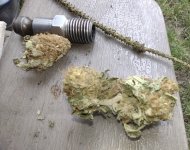led05
Chasing The Present
SMC/Durban x SMG I bred, pure frankies, beautiful near pure or pure NLD/sativa plant..... many have enjoyed seeds of it I've shared around.... here's a few pics, grown under LED, head to toe flowers, lower flowers are 6-7' below the lights..... Led can work
and it was packed with seeds, so didn't live up to it's potential by any means of course







and it was packed with seeds, so didn't live up to it's potential by any means of course



